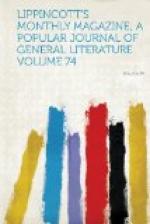I do not believe that it is any longer possible to obtain a complete copy of the above-mentioned work. Many years ago I found the separate sheets of it lying about in the sacristy in a manner which gave one a vivid idea of the reckless carelessness which is so marked a characteristic of Italians. Bundles of the different plates, some containing forty or fifty copies, some twenty or so, and some not more than four or five, were thrust into cupboards with wax candles for the altar, tattered choir-books and old candlesticks. And here was the whole remaining stock of the work! I was at that time able, by the exercise of much patience, trouble and persuasion with the old sacristan—who seemed to consider the sale of the plates a very insufficient recompense for the trouble of looking for them—to get together a complete copy of the work; but when I was there the other day not more than twenty of the plates out of nearly twice that number were to be found. In the mean time, however, a complete set of photographs of every portion of the sculpture has been made in a smaller size, but sufficiently large to give a very satisfactory representation of the extreme beauty and elegance of the work. It is indeed impossible to doubt that this Master Stephen of Bergamo, the carpenter, whose wife was to have half a crown a month for doing the washing and cooking for all the family living in the rooms assigned to them in the monastery for a workshop and living-rooms, was a man of education and culture, and in every sense of the word an artist. The difference between his social position and that of any artist of corresponding eminence in our day would seem to consist wholly in that greater degree of personal and material luxury which civilization and increased wealth have brought with them. The payment which he was to receive for his year’s work, besides having been maintained, lodged and fed at the cost of the monastery during the time, may, I take it, be considered equivalent to about twenty-two thousand five hundred dollars.




